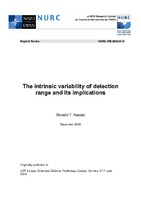| dc.description.abstract | The range of first detection of an approaching target is among the most important parameters defining sensors and defensive surveillance systems. A demonstration of capability typically consists of staged approaches of a target under realistic conditions in order to 1) assess detection range for mission planning, 2) show that the range of first detection occurs at notably greater range than competing systems, or 3) show that it exceeds a minimum performance specification. In port protection, for instance, it is common to demonstrate the performance of a sonar for the detection and tracking of underwater intruders by staging the approach of divers, or to demonstrate the performance of a radar for the detection of a fast boat by heading a boat toward the radar. The importance of detection range holds equally for combat systems. Like most quantitative observations, the observation of detection range is subject to random variability. That is, the same value is neither observed nor expected on repeated trials. It will vary instead depending in part on the constantly changing environmental conditions that affect a sensor's performance, and in part on the changing target-strength of the target owing to its construction, aspect, and speed, and in part on any intrinsic randomness in the nature of the detection process itself. The intrinsic uncertainty is the subject of this paper. At the limits of detection, a sensor system is by definition "straining" its utmost to distinguish a target in noisy or cluttered scene. Its probability of detection in a small time period is relatively low, for if it were high, one would not be speaking of the range limits of detection. Here it is shown by analysis that this in turn implies that there is a high intrinsic random variability in detection range that is not due to environmental or target strength uncertainties. Defensive response measures against a target must, as a minimum, be robust against this intrinsic variability in detection range. The interpretation of observed detection range must also take this intrinsic variability into account, when comparing one system against another or against performance specifications | |
